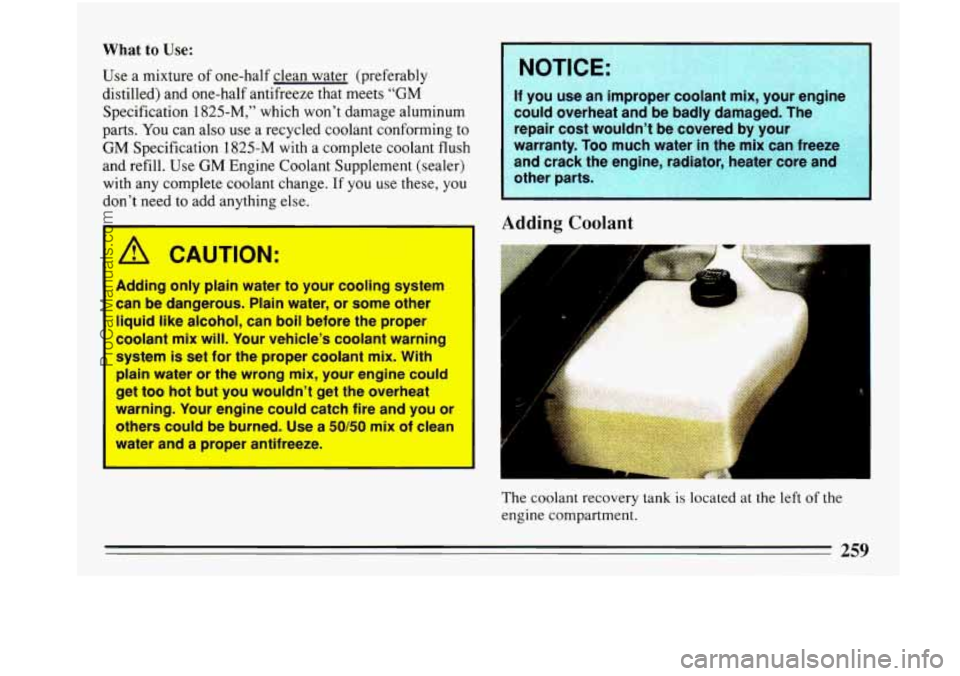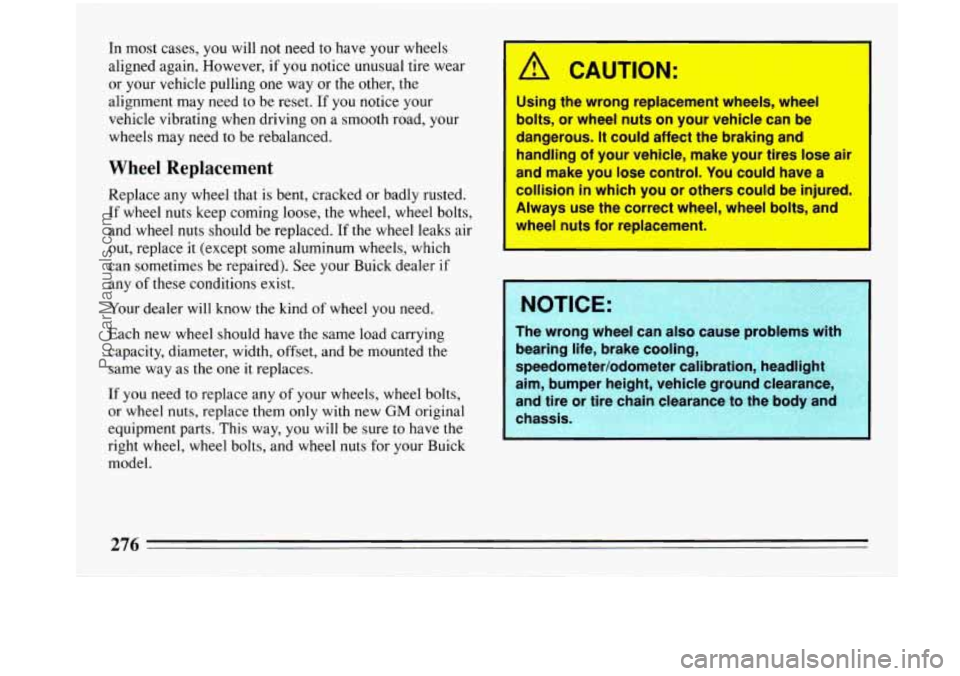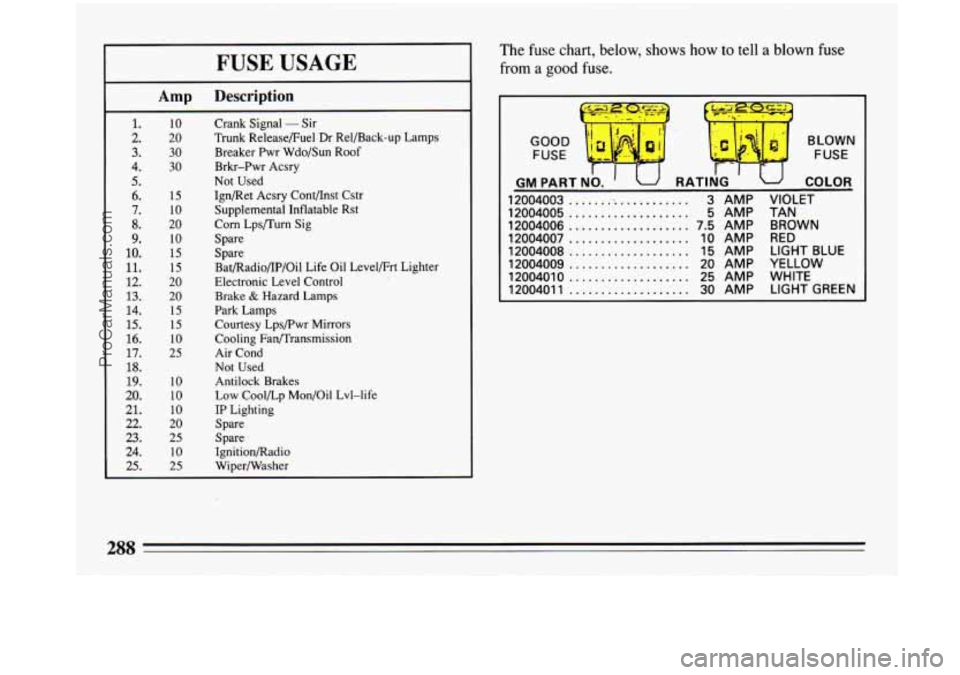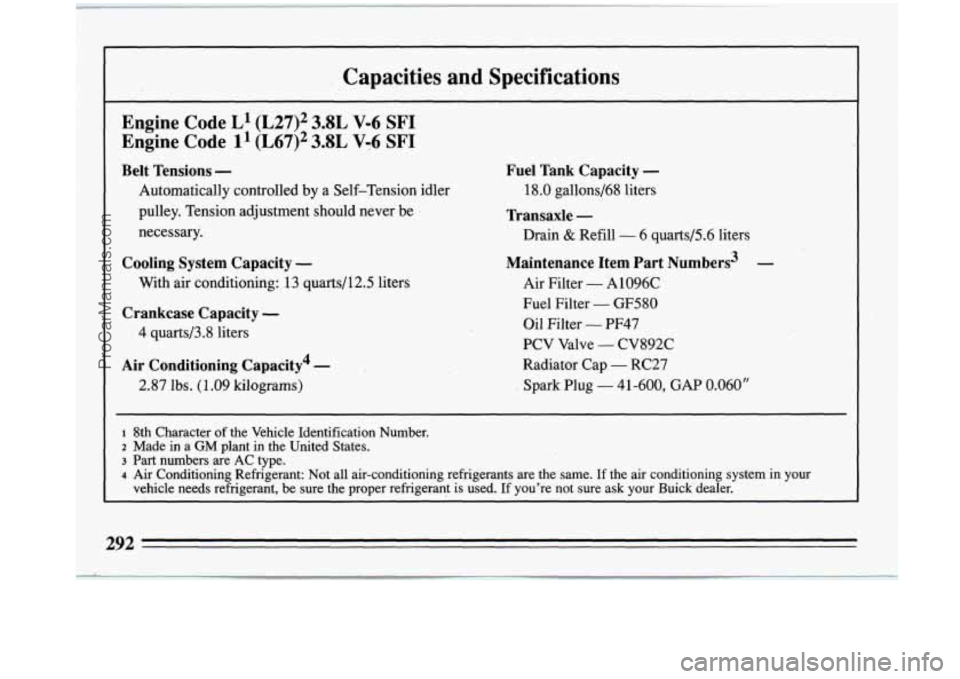Page 226 of 340
How to Add Coolant to the Coolant
Recovery
Tank
If you haven’t found a problem yet, but the coolant level In cold weather, water can free
isn’t at or above “FULL COLD,” add a 50/50 mixture
of clean water (preferably distilled) and the proper
antifreeze at the coolant recovery tank. (See “Engine
Coolant’’ in the Index for more information about the
proper coolant mix.)
I A CAUTION:
I Adding plain water to your cooling system can
be dangerous. Plain water, or some other liquid
like alcohol, can boll befare the proper coolant
mix will. Your vehicle’s coolant warning system
is set for the groper coolant mix. With plain water
.of the wrung mix, your engine could get too hot
but you wouldn’t get the overheat warning. Your
engine could catch fire and you or others could
be burned. Use a 50/50 mix of Glean water and a
proper antifreeze.
I
I
I
ProCarManuals.com
Page 227 of 340
A CAUTION: A CAUTION:
You can be burned if you spill cootant on hot
engine parts. Coolant contains ethylene glycol
and it will burn if the engine parts are hot
enough. Don’t spill coolant on a hot engine.
When the coolant in the coolant recovery tank is at or
above
“FULL COLD,” start your vehicle.
If the overheat warning continues, there’s one more
thing you can try.
You can add the proper coolant mix
directly
to the radiator, but be sure the cooling system is
cool before
you do it.
Steam and scalding liquids from a hot cooling
system can blow out and burn you badly. They
are under pressure, and if you turn the radiator
pressure cap
-- even a little -- they can come out
at high speed. Never turn the pressure cap when
e cooling system, including the radiator
pressure cap, is hot. Wait for the cooling system
and radiator pressure cap to cool
if you ever
have
to turn the pressure cap.
L
L
ProCarManuals.com
Page 228 of 340
How to Add Coolant to the Radiator
1 1. You can remove the
radiator pressure cap when the
cooling system,
including the
radiator pressure
cap and upper
radiator hose,
is no
longer hot.
Turn the pressure cap slowly to the
left until it first
stops. (Don't press
down while turning the pressure
cap.)
2. Then keep turning the pressure cap,
but now push down
as
you turn it.
Remove the
pressure cap.
1
If you hear a hiss, wait for that to stop. A hiss means I
there is still some pressure left. i
3. Fill the radiator
with the proper
mix, up to the base
of the filler neck.
ProCarManuals.com
Page 260 of 340

2. Push it back in all the way, wait three seconds and
then pull it back out again.
3. Check both sides of the dipstick, and read the lower
level. The fluid level must be in the cross-hatched
area.
4. If the fluid level is where it should be, push the
dipstick back
in all the way.
How to Add Fluid:
Refer to the Maintenance Schedule to determine what
kind of transaxle fluid to use. See “Recommended
Fluids and Lubricants” in the Index.
If the fluid level is low, add only enough of the proper
fluid to bring the level
into the cross-hatched area on the dipstick, It
doesn’t take much fluid, generally less than a
pint. Don’t overfill. We recommend
you use only fluid
labeled DEXRONWIE, because
fluids with that label
are made especially for your automatic transaxle.
Damage caused by fluid other than DEXRONB-IIE is
not covered by your new vehicle warranty.
0 After adding fluid, recheck the fluid level as
described under “How to Check.”
When the correct fluid level is obtained, push the
dipstick back
in all the way.
Engine Coolant
The following explains your cooling system and how to
add coolant when
it is low. If you have a problem with
engine overheating, see “Engine Overheating” in the
Index.
The proper coolant for your Buick will:
0 Give freezing protection down to -34°F (-37 “C) .
0 Give boiling protection up to 262 F ( 128 ” C) .
0 Protect against rust and corrosion.
0 Help keep the proper engine temperature.
0 Let the warning lights work as they should.
ProCarManuals.com
Page 261 of 340

What to Use:
Use a mixture of one-half clean water (preferably
distilled) and one-half antifreeze that meets “GM
Specification
1825-M,” which won’t damage aluminum
parts.
You can also use a recycled coolant conforming to
GM Specification
1825-M with a complete coolant flush
and refill. Use GM Engine Coolant Supplement (sealer)
with any complete coolant change. If you use these, you
don’t need
to add anything else.
A CAUTION:
Adding only plain water to your cooling system
can be dangerous. Plain water, or some other
liquid like alcohol, can boil before the proper
coolant mix will. Your vehicle’s coolant warning
system
is set for the proper coolant mix. With
plain water or the wrong mix, your engine could
get too hot but you wouldn’t get the overheat
warning. Your engine could catch fire and you or
others could be burned. Use
a 50/50 mix of clean
water and a proper antifreeze.
If you use an improper coolant mix, your
engine :,,I could overheat and be badly damaged. The’: . -
repair cost wouldn’t be covered by your -.. - ’
warranty. Too much water in the mix can !ete;::
and crack the engine, radiator, heater
Core and
other parts.
~. -.- . ~. .. ..._ - . . :-: -. ~ . . ~.., -
Adding Coolant
6
The coolant recovery tank IS located at the left of the
engine compartment.
259
ProCarManuals.com
Page 278 of 340

In most cases, you will not need to have your wheels
aligned again. However, if
you notice unusual tire wear
or your vehicle pulling one way or the other, the
alignment may need to be reset.
If you notice your
vehicle vibrating when driving on a smooth road, your
wheels may need to be rebalanced.
Wheel Replacement
Replace any wheel that is bent, cracked or badly rusted.
If wheel nuts keep coming loose, the wheel, wheel bolts,
and wheel nuts should be replaced.
If the wheel leaks air
out, replace it (except some aluminum wheels, which
can sometimes be repaired). See your Buick dealer if
any
of these conditions exist.
Your dealer will know the kind
of wheel you need.
Each new wheel should have the same load carrying
capacity, diameter, width, offset, and be mounted
the
same way as the one it replaces.
If
you need to replace any of your wheels, wheel bolts,
or wheel nuts, replace them
only with new GM original
equipment parts. This way, you will be sure
to have the
right wheel, wheel bolts, and wheel nuts for your Buick
model.
A CAUTION:
Using the wrong replacement wheels, wheel
bolts, or wheel nuts on your vehicle can be
rngerous. It could affect the braking and
.. ~ndling of your vehicle, make your tires lose air
and make you lose control. You could have a
collision
in which you or others could be injured.
- ..ways use the correct wheel, wheel bolts, ~ d
I wheel nuts
for replacement.
I
1: NOTICE:
The wrong wheel can atso cause Droblems with
bearing life, brake cooling,
speedometer/odometer calibration, headllgb,,
aim, bumper height, vehicle ground clearance
and tire or tire chain clearance to the body an(
chassis.
ProCarManuals.com
Page 290 of 340

FUSE USAGE
Amp Description
1.
2.
3.
4.
5. 6.
7.
8.
9.
10.
11. 12.
13.
14.
15.
16. 17.
18.
19.
20.
21.
22.
23.
24.
25.
10
20
30
30
15
10
20
10
15
15
20
20
15
15
10
25
10
10
10
20
25
10
25
Crank Signal - Sir
Trunk Release/Fuel.Dr Rel/Back-up Lamps
Breaker Pwr Wdo/Sun Roof
Brkr-Pwr Acsry
Not Used
Ign/Ret Acsry ContDnst Cstr
Supplemental Inflatable Rst
Corn Lps/Turn Sig
Spare
Spare
Bat/Radio/IP/Oil Life Oil Level/Frt Lighter
Electronic Level Control
Brake
& Hazard Lamps
Park Lamps
Courtesy Lps/Pwr Mirrors
Cooling Fan/Transmission
Air Cond
Not Used
Antilock Brakes
Low Cool/Lp Mon/Oil Lvl-life
IP Lighting
Spare
Spare
IgnitionBadio
Wiperwasher
The fuse chart, below, shows how to tell a blown fuse
from a
good fuse.
GOOD
FUSE 1 BLOWN .r, ' \' gJ
'TI r
FUSE
GM PART NO. ' RATING ' COLOF
12004003 .................... 3 AMP VIOLET
12004005
................... 5 AMP TAN
12004006
................... 7.5 AMP BROWN
12004007
................... 10 AMP RED
12004008
................... 15 AMP LIGHT
BLUE
12004009
................... 20 AMP YELLOW
12004010
................... 25 AMP WHITE
1200401
1 ................... 30 AMP LIGHT
GREEN
ProCarManuals.com
Page 294 of 340

Capacities and Specifications
Engine Code L1 (L27)2 3.8L V-6 SF1
Engine Code
l1 (L67)2 3.8L V-6 SF1
Belt Tensions -
Automatically controlled by a Self-Tension idler
pulley. Tension adjustment should never be
necessary.
Cooling System Capacity -
With air conditioning: 13 quarts/l2.5 liters
Crankcase Capacity -
4 quarts/3.8 liters
Air Conditioning Capacity4 -
2.87 lbs. (1.09 kilograms)
Fuel Tank Capacity -
18.0 gallons/68 liters
Transaxle -
Drain & Refill - 6 quarts/5.6 liters
Maintenance Item Part Numbers3 -
Air Filter - A1096C
Fuel Filter
- GF580
Oil Filter
- PF47
PCV Valve
- CV892C
Radiator Cap
- RC27
Spark Plug
- 41-600, GAP 0.060”
~~~~ ~~~ -. ____ ____ ~~ -. ~~ ~ ~~ ~ ~
1 8th Character of the Vehicle Identification Number.
2 Made in a GM plant in the United States,
3 Part numbers are AC type.
4 Air Conditioning Refrigerant: Not all air-conditioning refrigerants are the same. If the air conditioning system in your
vehicle needs refrigerant, be sure the proper refrigerant is used.
If you’re not sure ask your Buick dealer.
292
ProCarManuals.com